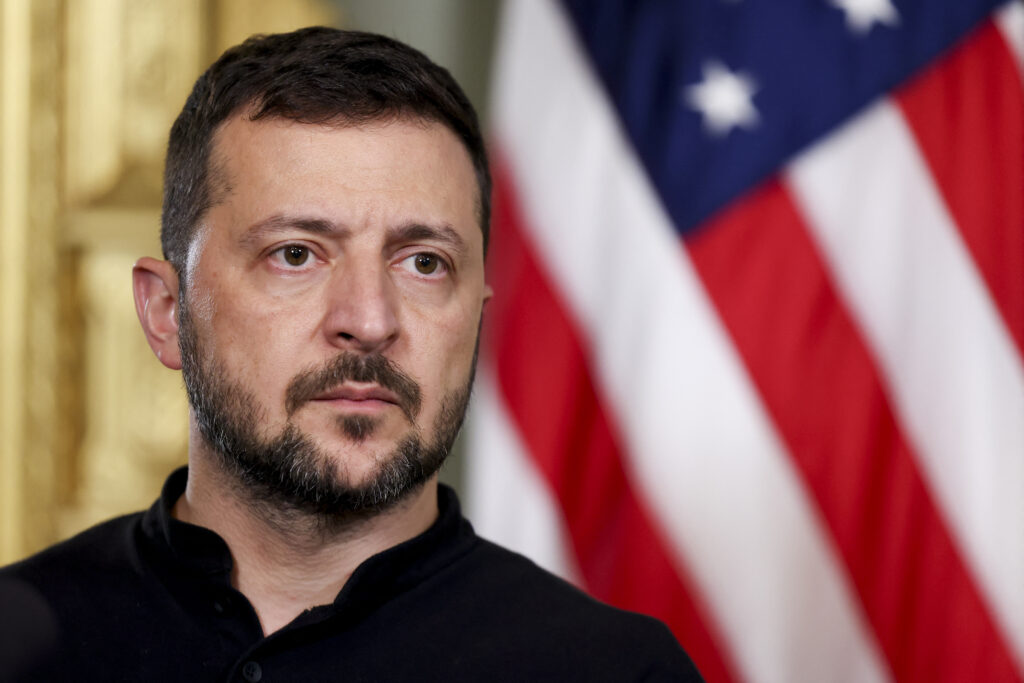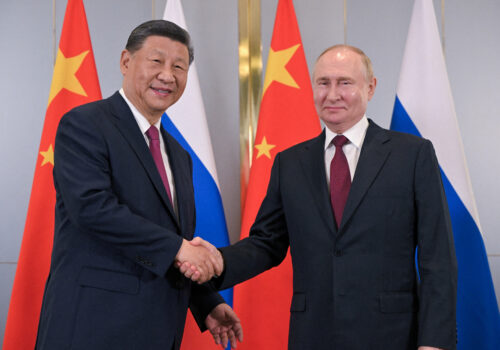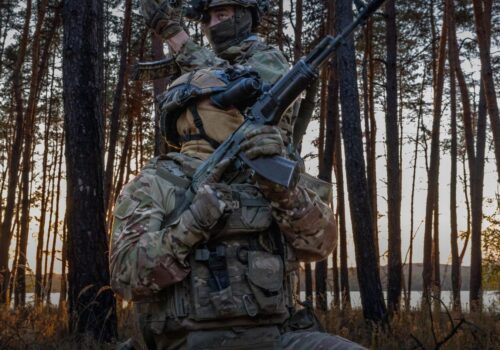The storm clouds may be parting after Zelenskyy’s tumultuous US visit
It has been quite a week for Ukrainian President Volodymyr Zelenskyy. He arrived in New York on Sunday to address the United Nations General Assembly and meet with world leaders. But his real agenda was to meet with US President Joe Biden and presidential candidates Kamala Harris and Donald Trump. From Biden, he wanted permission to use US Army Tactical Missile Systems (ATACMS)—accurate missiles with a range of three hundred kilometers—on military targets in Russia. With Trump and Harris, Zelenskyy wanted to renew and strengthen his relationship before the US presidential election that will make one of them president in four months.
Zelenskyy’s interactions with Biden and Harris were predictable. It was no surprise that the Ukrainian president did not persuade his US counterpart to permit the use of ATACMs in Russia. Since the start of Moscow’s full-scale invasion, Russian President Vladimir Putin has managed to get into Biden’s head with nuclear bluster. Putin’s decision this week to “revise” Russian doctrine to establish a lower threshold for using nuclear weapons gave Biden one more reason to put off making a sensible and necessary decision to aid Ukraine’s war effort. Aside from that expected point of divergence, the meeting of the two presidents was amicable, with Biden stating his support for a Ukrainian win in the war and the administration announcing a new tranche of weapons (worth nearly eight billion dollars) heading to Ukraine, including for the first time Joint Standoff Weapons—an air-launched glide bomb with a range of seventy miles. The Harris meeting was also low drama. There was a warm exchange, with Harris saying afterwards that she strongly supported Ukraine and that her position on Russia’s aggression contrasted with Trump’s.
All the drama in Zelenskyy’s trip centered on his relationship with Trump. Of course, the connection between the two has not been easy since the controversial phone call in July 2019 that featured in the first impeachment process against Trump. But the relationship at least partly normalized earlier this year when Trump enabled Republican House Speaker Mike Johnson to put to a vote in April the supplemental aid package that a small group of populist Republicans had blocked for seven months. This was followed by a friendly phone call between the two this summer.
Zelenskyy did two things on Sunday that turned his trip upside down.
Coming to the United States, Zelenskyy was well aware that there are contending factions within the Republican Party and the Trump team on aid to Ukraine. One side recognizes that Russia treats the United States as its principal adversary and seeks to undermine NATO. Therefore, the United States has vital interests in helping Ukraine defeat Putin’s aggression. The other side ignores the danger for the United States posed by Russian policies and fails to see the importance of aiding Ukraine. Even though the second group includes Trump’s vice-presidential pick and oldest son, Trump has not committed to either view.
Zelenskyy did two things on Sunday that turned his trip upside down, although that did not become evident for a couple of days. First, he visited a US Army ammunition plant in Scranton, Pennsylvania, to thank the workers there for making rounds for Ukraine’s defense and to oversee the signing of an agreement between Pennsylvania Governor Josh Shapiro and his Zaporizhzhia counterpart on regional cooperation; Zelenskyy had done the same on a trip to Utah—where he was hosted by the state’s Republican governor—earlier in the year. Second he did an interview with the New Yorker in which he referred to Republican vice presidential nominee JD Vance’s “radical” views on Ukraine.
By Tuesday, these two developments had created a firestorm in Republican circles. Many Republicans called the trip to Scranton a political rally to help the Democrats in the swing state of Pennsylvania. While the anti-Ukraine faction in the Republican Party jumped on this as a way to influence Trump’s views on Ukraine, many stalwart supporters of Ukraine also slammed the trip. Many also called out Zelenskyy for his criticism of Vance. (While Zelenskyy’s characterization of Vance’s position on Ukraine was milder than some Republicans, such as Senator Thom Tillis, he had no need to comment.) As part of this furor, Johnson called on Zelenskyy to fire Ukraine’s ambassador to the United States, Oksana Markarova. Perhaps even more unsettling, Trump himself began to criticize Zelenskyy and Ukraine for not ceding some territory in a bid to end the war with Putin; and the Trump team refused to confirm a meeting with Zelenskyy.
This drama lasted a bit more than two full days. By Thursday evening, perhaps not coincidentally just hours after Zelenskyy’s meetings with Biden and Harris, the news broke that Trump would see the Ukrainian president in New York on Friday. They met, jointly spoke with the press, and described a cordial exchange. And from Thursday evening, all Republican criticism of Zelenskyy and Ukraine ceased. When questioned by the media, Trump refused to say that Ukraine should give up territory to make peace. When Johnson appeared on Fox News on Friday, he expressed displeasure about Zelenskyy’s Scranton trip but refused to back off his support for the April spending bill and did not rule out further aid for Ukraine next year—though he was quick to add that he expects Trump to be in the White House “to direct how all that is handled.”
We cannot be sure what happened, but the answer may lie in the fact that a majority of Americans are in favor of maintaining or increasing aid to Ukraine. In addition, Pennsylvania is perhaps the most important swing state in the November election, with more than 800,000 Ukrainian- and Polish-Americans who are more likely than most to understand that Putin is threatening Ukrainian extinction and considers the United States an enemy. Whatever the explanation for this turn of events, it is bad news for the naifs on the political right who see no problem in abandoning Ukraine to Putin’s tender mercies. And that is good for the United States.
John E. Herbst is senior director of the Atlantic Council’s Eurasia Center and served for thirty-one years as a foreign service officer in the US Department of State, retiring at the rank of career minister. He was US ambassador to Ukraine from 2003 to 2006.
Further reading
Sat, Sep 28, 2024
The US confronts two global threats: China-Russia and itself
Inflection Points By Frederick Kempe
NEW YORK—Two dark clouds hung over the United Nations General Assembly this week in New York. The first was the growing peril of Chinese-Russian common cause. The second was uncertainty about whether US leadership will rise to the challenge after the November elections. It’s impossible to separate the two issues, as the disruptive dangers of […]
Wed, Sep 18, 2024
Dispatch from Kyiv: The Kursk offensive is working, but Ukrainians are worried about US wobbling
New Atlanticist By John E. Herbst
Morale in Kyiv has been boosted by the early success of the incursion into Kursk, but tempered by concerns over US support.
Thu, Sep 19, 2024
Compromising with the Kremlin in Ukraine will only embolden Putin
UkraineAlert By Kateryna Odarchenko, Elena Davlikanova
JD Vance recently claimed a Trump peace plan would include letting Russia retain occupied areas of Ukraine. But any concessions to the Kremlin will only embolden Putin and invite more war, write Kateryna Odarchenko and Elena Davlikanova.
Image: Volodymyr Zelenskiy, Ukraine’s president, during a meeting with USA Vice President Kamala Harris, not pictured, in the Vice President’s Ceremonial Office in Washington, DC, USA, on Thursday, September 26, 2024. Photo by Ting Shen/Pool/ABACAPRESS.COM




